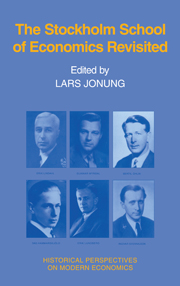Book contents
- Frontmatter
- Dedication
- Contents
- Preface
- List of Contributors
- Dramatis Personae at the end of 1937
- Introduction and Summary
- Part I The roots
- Part II The approach of the Stockholm School
- Part III The impact of the Stockholm School
- 15 The Swedish influence on Value and Capital
- 16 The London School of Economics and the Stockholm School in the 1930s
- 17 Thoughts on the Stockholm School and on Scandinavian economics
- 18 Ragnar Frisch and the Stockholm School
- 19 The late development of the Stockholm School and the criticism from John Åkerman
- Part IV What remains of the Stockholm School?
- The Stockholm School: A non-Swedish bibliography
19 - The late development of the Stockholm School and the criticism from John Åkerman
Published online by Cambridge University Press: 05 July 2013
- Frontmatter
- Dedication
- Contents
- Preface
- List of Contributors
- Dramatis Personae at the end of 1937
- Introduction and Summary
- Part I The roots
- Part II The approach of the Stockholm School
- Part III The impact of the Stockholm School
- 15 The Swedish influence on Value and Capital
- 16 The London School of Economics and the Stockholm School in the 1930s
- 17 Thoughts on the Stockholm School and on Scandinavian economics
- 18 Ragnar Frisch and the Stockholm School
- 19 The late development of the Stockholm School and the criticism from John Åkerman
- Part IV What remains of the Stockholm School?
- The Stockholm School: A non-Swedish bibliography
Summary
For many economists, the Stockholm School came to an end around 1937 when Bertil Ohlin gave it a name and based it on earlier contributions by Swedish economists. The “battle” was then lost to John Maynard Keynes, whose method, while less genuinely dynamic, was easier to handle. A discussion of the macroeconomics of the Stockholm School up to 1937 still appears to be of interest and underlines the role of Bertil Ohlin, Erik Lindahl, and Erik Lundberg as prominent members of the School.
To restate the critique of the Stockholm School by Johan Åkerman implies focusing on a very special part of the work carried out within the School. To understand his critique, we cannot restrict ourselves to the years before 1937 and to merely the macroeconomics of those years. When Åkerman is critical toward the Stockholm School, he is critical toward a method and a microeconomic construction.
During the years following 1937 the Stockholm School came to be associated with a method within Sweden. The cornerstones of that method were plans, periods, and expectations. They were microeconomic concepts and were fully elaborated after 1937. Maybe it would be wise to talk about a “late Stockholm School” in this context (see Petersson, 1987). The idea of change within the Stockholm School is not a new one. Otto Steiger (1971) suggested such a division and Björn A.
- Type
- Chapter
- Information
- The Stockholm School of Economics Revisited , pp. 435 - 443Publisher: Cambridge University PressPrint publication year: 1991

